New Tool Measures Your Facebook Page EdgeRank Score
 Getting your Facebook fan page posts seen in the News Feeds is one of the most important – and elusive – aspects of marketing on Facebook. Jeff Widman of BrandGlue.com discovered that some 88% of Facebook users never return to a fan page once they’ve clicked the Like button. Instead, they see and engage with your content in their News Feed.
Getting your Facebook fan page posts seen in the News Feeds is one of the most important – and elusive – aspects of marketing on Facebook. Jeff Widman of BrandGlue.com discovered that some 88% of Facebook users never return to a fan page once they’ve clicked the Like button. Instead, they see and engage with your content in their News Feed.
Your News Feed has two main filters
1. TOP NEWS. When accessing Facebook via the web, the default view is always set to “Top News.” (“News Feed” is your Home Page that you see when you first log in to Facebook). Top News is only a *selection* of your friends’ activity and the activity of fan pages you’ve joined (liked). Just because you like a Facebook fan page, doesn’t mean you’ll suddenly see all their updates in your News Feed. The more friends you have and the more Facebook pages you like, the more overwhelming your News Feed would get – this is why Facebook has their sophisticated algorithm called “EdgeRank” in place. More on this further below.
2. MOST RECENT. There’s also a second filter on your News Feed, and that is “Most Recent,” which is a real-time stream of activity from your friends and fan pages you’ve joined. I have seen reports that about half of all Facebook users just stick with the default view of Top News – most likely because they simply don’t know about other ways to view their News Feed, such as Most Recent, Photos, Links, Pages, and Lists. In the screenshot below, you can see I’ve selected to view the News Feed of just Pages.
By the way, it’s important to note that the default News Feed view for Facebook mobile is Most Recent – still referred to as “Live Feed,” as it used to be on the main site. And, given over 200 million Facebook users access the site via their mobile devices – and they are twice as active – you do stand a good chance of having your fan page content seen by your fans who are mobile users.
What is EdgeRank?
Facebook created a three-pronged algorithm that scores each and every piece of content on Facebook – whether made by a personal profile or fan page. The content with the highest EdgeRank score gets shown in the “Top News” News Feed filter.
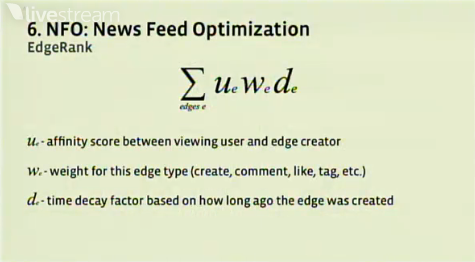
Facebook EdgeRank – News Feed Formula
Here’s EdgeRank explained in slightly more plain English! 🙂
- Affinity = the relationship between you and each individual fan. That is, how often a fan views and interacts with your Facebook page and individual posts. Plus, how much you engage with your fans: Facebook rewards you for building relationships!
- Weight = typically, photos receive the highest weight, followed by videos, links, status updates and apps. Manual posts receive more weight than posts by apps.
- Time = the more recent your post, the higher your EdgeRank score. A popular piece of content will stay for a longer period of time in the News Feed of your fans.
I also believe older fan pages have an advantage over brand new ones – much like the “aging” system on Google. Plus, it certainly appears the more (active) fans you have, the higher your EdgeRank. So, it can be tricky to really crank up the momentum. Take a look at these posts if you’re looking to boost your fanbase and fan engagement.
Introducing… EdgeRank Checker to track your score!
Now that you’re more familiar with Facebook’s “EdgeRank,” what it means, and how important it is to understand the process, here is a brand new tool to measure your EdgeRank, simply called “EdgeRank Checker.”
The tool is simple to use and walks you through the steps, complete with helpful screenshots if you need them. Go to your Insights and click the fan page you wish to check > then select the date range you want > click the Export button > select CSV. Then upload that CSV file to EdgeRank Checker > voila! The app worked very fast and provided my score almost instantaneously.
Pros
- A nice, simple way to keep track of your EdgeRank score – especially for those Page Admins who are not doing any kind of deep analysis (highly recommended, though!).
- By varying the date range on your CSV export file, you can check your EdgeRank score for any period of time you wish: an entire year, month, week or just a day.
- Any size fan page can measure their EdgeRank. And, contrary to what I said above about larger pages performing better, EdgeRank Checker states, “A small and effective Facebook Page with high EdgeRank can out perform a large Facebook Page with low EdgeRank in terms of per user visibility.”
Cons
- It’s not clear what happens to the data uploaded in your CSV file; there’s no small print to explain.
- (However, keep in mind third-party apps could have access to your Insights data anyway. To illustrate, take a look at this app I just discovered thanks to a tweet from Marty Weintraub, “Most Invasive App EVER!” – you’ll see a list of every piece of data that apps could access. Do not click the Allow button on that app, it’s just to demo the data!)
- There is scant information about EdgeRank Checker’s creator and the company behind it on both the app page and company page.
- There’s no way to measure the EdgeRank score on individual posts.
- However, by tracking your own Insights and per-post analytics provided on your page, you can get a good sense over time of your fans’ best responses to the individual types of posts and optimal times.
- I’d like to see a faster way of measuring than the five-step process involving downloading and uploading, as simple as it is!
- (For example, check out the fan engagement checker at Fangager.com – just pop in your fan page username and get a full summary report. Not quite faster, but certainly more comprehensive. Props to Brian Solis for the tip on this one. I’ll be reviewing Fangager in an upcoming blog post).
“EdgeRank Checker” was created by EdgeRank Expert, Chad Wittman, founder of SBN. I reached out to Chad for additional information on the EdgeRank Checker tool and he was very gracious in providing a number of details. Regards the issue of the uploaded CSV file, Chad had this to say:
Within the raw CSV file, the user’s page name (other than the actual file name, which can easily be changed) isn’t given nor recorded which helps add a layer of confidentiality. Users can be certain that we are very thankful for their use of our app and we will not abuse any of the data we collect.
User feedback is vital, as we understand this is, in part, a community effort.
What’s a good score?
According to EdgeRank Checker, they created their own algorithm (“admittedly a work in progress”) by comparing a multitude of Facebook Pages. Their score breakdown is as follows:
- 0-3 = below average.
- 4-7 = average.
- 7+ = above average.
- Scores above 20 are excellent.
- Pages with a very low amount of fans will most likely result in very high numbers due to a small sample size.
I tested out my own score over several periods of time and was pleased to see scores of 21+ on some weeks/months. I also measured a recent highly active day, in particular, when I hosted a “Virtual Fan Page Party” to celebrate passing 30,000 members. My EdgeRank score on that day was 34! Nice. 😉
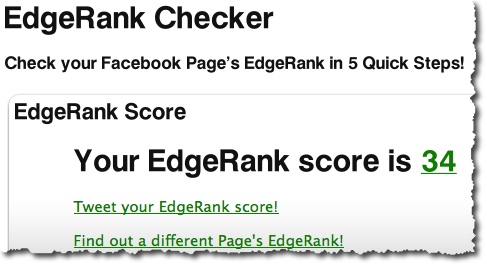
Facebook’s EdgeRank is a complex topic that few people, other than Facebook staff, truly understand. I’ve listed below some additional sources of information to help you begin to master this topic!
Meantime, do let me know in the comments below if you try the EdgeRank Checker tool and if it’s helpful to you. Or does it make more sense to you to just track your Insights? Do you export your data and crunch the numbers to improve your News Feed visibility?
Recommended reading:
- EdgeRank: The Secret Sauce That Makes Facebook’s News Feed Tick (techcrunch.com)
- Facebook News Feed Settings: Random Or Not, Biggest Secrets Revealed (thedailybeast.com)
- The Mystery of The Facebook News Feed: How to Optimize The Hidden Jewel of Facebook (likeablemedia.com)
- Facebook Edgerank Algorithm explained (kluriganalytics.com)
- Anatomy of a Facebook Post: Vitrue’s Data Behind Effective Social Media Marketing (vitrue.com)
- Top Posts Filter Surfaces the Best User Content on Facebook Page Walls (insidefacebook.com)
- Why Facebook EdgeRank And News Feed Optimization Will Matter To Marketers In 2011 (liveworld.com)
[Props to my Facebook page member, Roshan Khan, founder of SocialRank, for the headsup on EdgeRank Checker.]

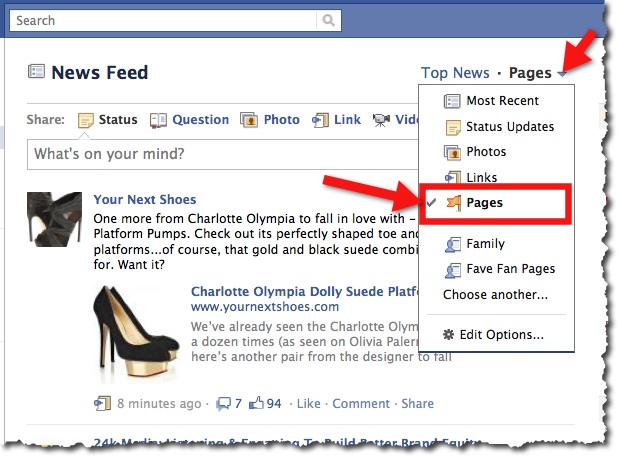
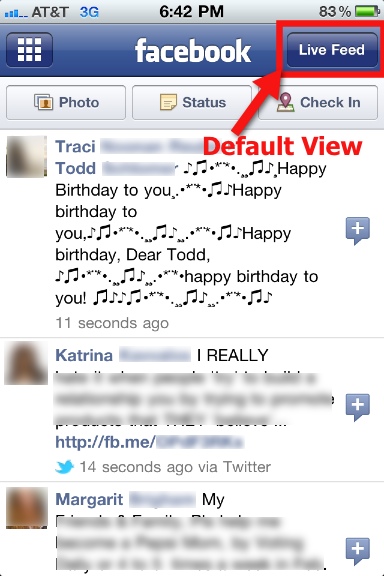
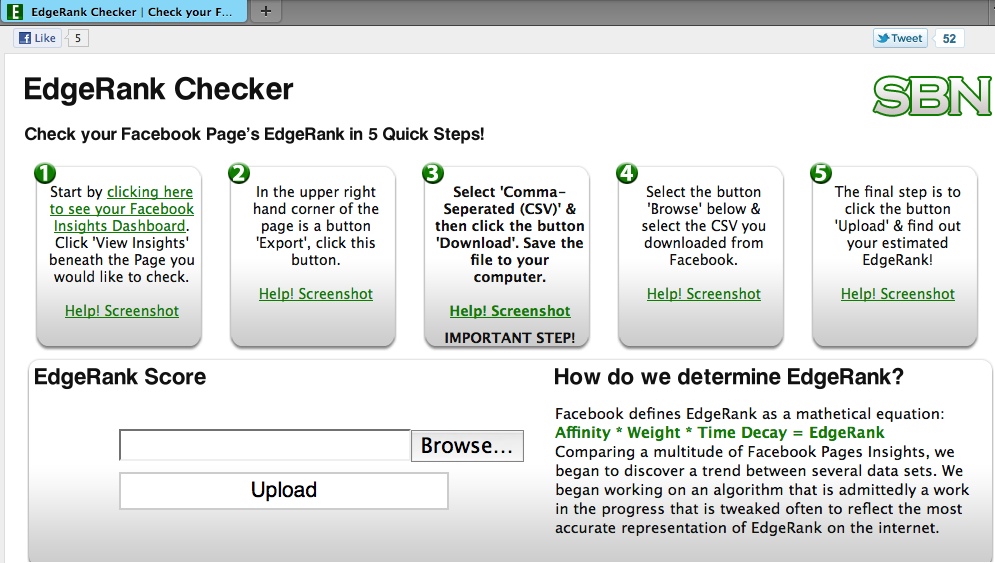
Hi, can I check who’s viewing my Profile page and Timeline?
Thanks for the update , i did not have to upload the csv file , just gave the app access and it provided me the detials based on each page.
What should be the date range. should it be 15 days or a month
Hi Mari – I heard that when it comes to EdgeRank, in order for all your fans to see a post 1% of your fans must engage with that post. So a fan page with 100,000 fans will need 1,000 comments or likes to ensure all 100,000 fans see that post. Have you heard this? Does 1% seems reasonable?
Thanks for this Facebook Page Edgerank post Mari. @SheilaS mentioned it during #BlogChat tonight (Topic Facebook Page versus Blog). I made sure to bookmark it on StumbleUpon so that I can come to it.
Mari, Heard your presentation on Bloogig Success Summit so came here to “check it out”. Thanks for being a fount of information. At this point most of the information in this post is over my head, but I’m learning. We need leaders like you to lead us out of the wilderness.
Well Mari, looks like I have some more work a head of me 🙂
Jeff
Mari,
Is this any than that number we used to see in our insights bar on our wall?
Mari – Great post! Just tested ours and it’s 38! Not too shabby:)
Good article Mari, always good to hear more about the inner workings of #Facebook
Love this my pages ranked from 13 to 47. This is good infomation to have!!